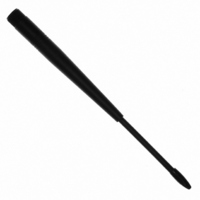0600-00027 Laird Technologies, 0600-00027 Datasheet - Page 10

0600-00027
Manufacturer Part Number
0600-00027
Description
ANTENNA 915MHZ 1/2WV 7" RPSMA
Manufacturer
Laird Technologies
Specifications of 0600-00027
Antenna Type
Whip: 1/2 Wave, Swivel, Tilt (Right Angle)
Number Of Bands
1
Frequency
902MHz ~ 928MHz
Vswr
2
Gain
2dBi
Termination
RP-SMA
Mounting Type
Connector
Height (max)
8.25" (209.5mm)
Impedance
50 Ohms
Technology Type
1/2 Wave Wireless Transceiver Antenna
Termination Style
RPSMA
Lead Free Status / RoHS Status
Lead free / RoHS Compliant
Lead Free Status / RoHS Status
Lead free / RoHS Compliant, Lead free / RoHS Compliant
Theory of Operation
MASTERLESS ARCHITECTURE
The Masterless architecture is a true peer-to-peer architecture, where any module that has data to transmit will initiate a
communication Session with a transceiver(s) within its range, transmit data and exit the Session. This architecture eliminates the
need for a master which dictates data flow control, hence reducing additional system overhead and greatly improving efficiency.
Modes of Operation
Figure 1 - Modes of Operation
Transmit Mode
Any radio with data to transmit initiates a Session with other radios by transmitting a 25ms Sync Pulse. Once a Session is
established the radio enters Transmit Mode and transmits the data during the remaining 25 ms of the current hop;
remaining in Transmit Mode its’ Session Count expires. When transmitting an Addressed packet the Session Count is
defined by Session Count Refresh (EEPROM address 0xC4) + number of Transmit Retries (EEPROM address 0x4C).
When transmitting a Broadcast packet Session Count is defined by Session Count Refresh (EEPROM address 0xC4) +
Broadcast Attempts (EEPROM address 0x4D). Once the radio exits the Session it returns to Receive Mode.
Addressed Packets: The RF packet is sent out to the receiver designated by the Destination Address. Transmit Retries are
used to increase the odds of successful delivery to the intended receiver. Transparent to the OEM Host, the sending
transceiver will send the RF packet to the intended receiver. If the receiver receives the packet free of errors, it will return an
RF Acknowledge. If the sender does not receive this acknowledge, it will assume the packet was never received and retry
the packet. This will go on until the packet is successfully received or the transmitter exhausts all of its retries. The received
packet will only be sent to the OEM Host if and when it is received free of errors.
Broadcast Packets: The RF packet is broadcast out to all eligible receivers on the network. Broadcast Attempts are used to
increase the odds of successful delivery to the intended receiver(s). Transparent to the OEM Host, the sending transceiver
will send the RF packet to the intended receiver. If the receiver detects a packet error, it will throw out the packet. This will
go on until the packet is successfully received or the transmitter exhausts all of its attempts. Once the receiver successfully
receives the packet, it will send the packet to the OEM Host. It will throw out any duplicates caused by further Broadcast
Attempts. The received packet will only be sent to the OEM Host if it is received free of errors. If API or hardware
acknowledgement is enabled, a broadcast packet will always report success.
The AC4790 has three different operating modes: Transmit Mode, Receive Mode and
Command mode. When not in Transmit or Command Mode the radio will be in Receive
Mode ready to receive data and awaiting a sync pulse from another transceiver. A
transceiver will enter either Transmit or Command Mode when its OEM Host sends data
over the serial interface. The state of the Command/Data pin (Pin 17) or the data
contents determine which of the two modes will be entered.
10




















